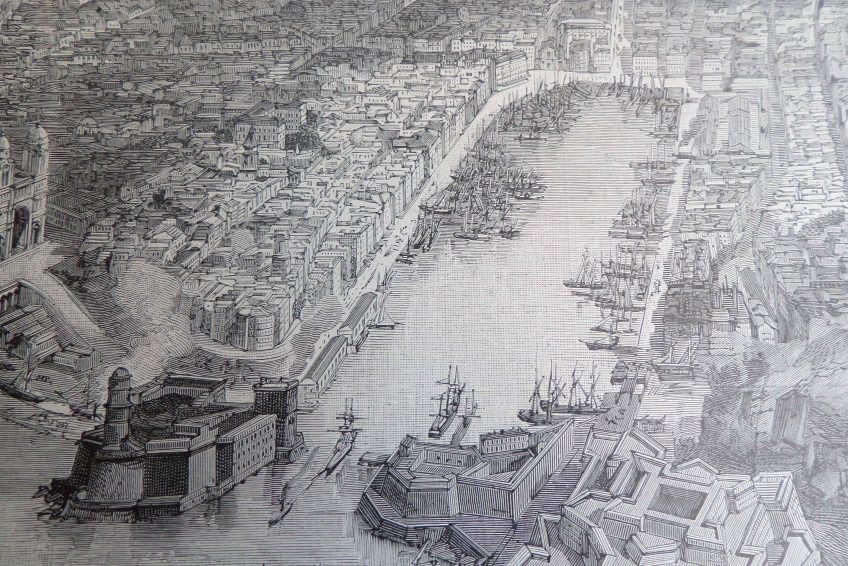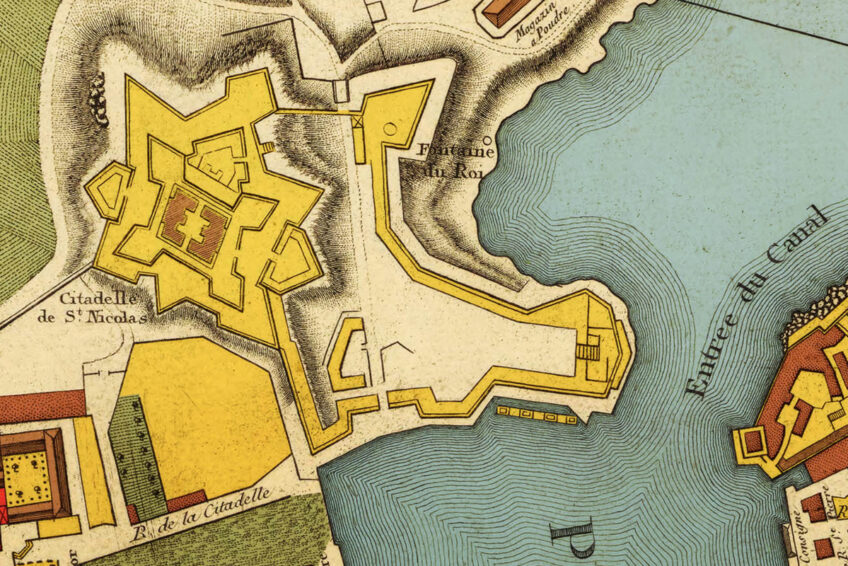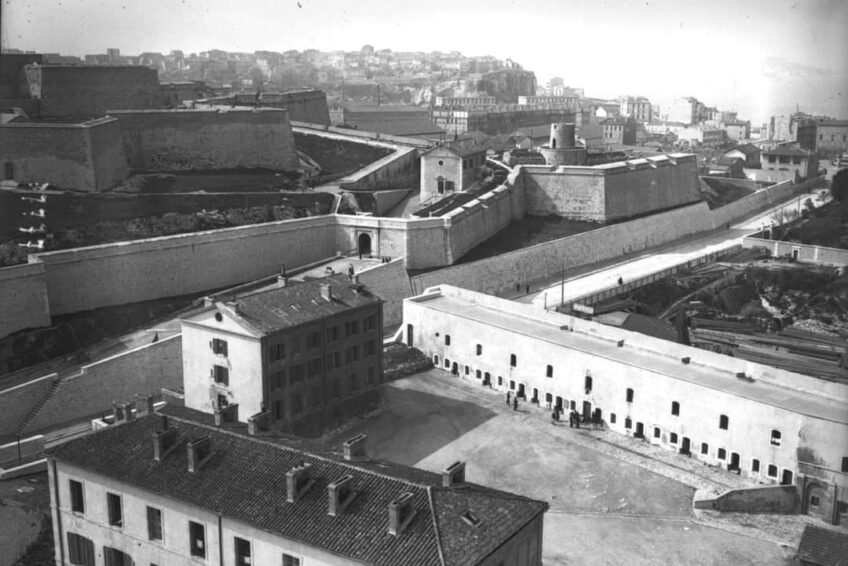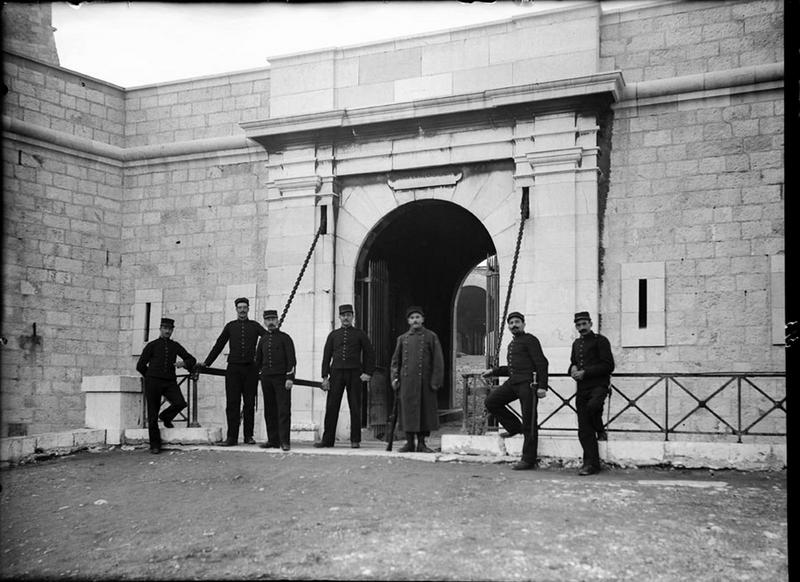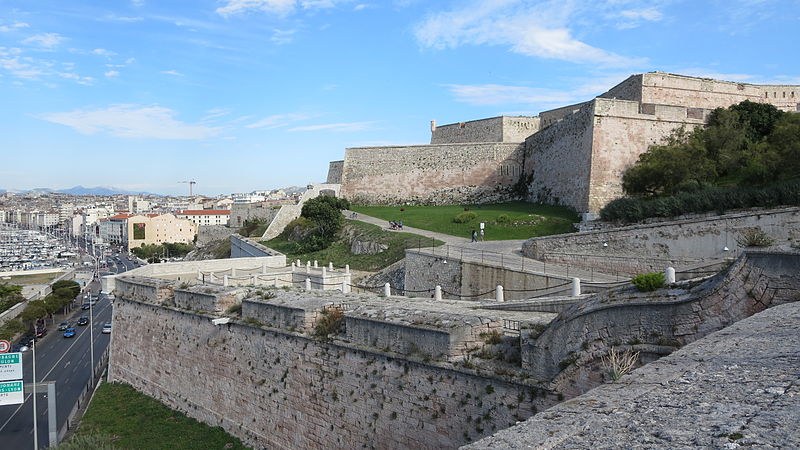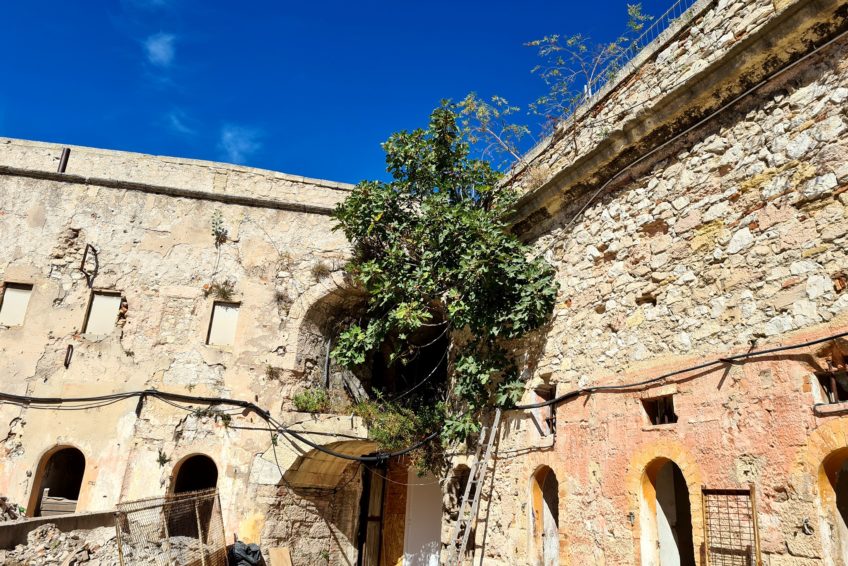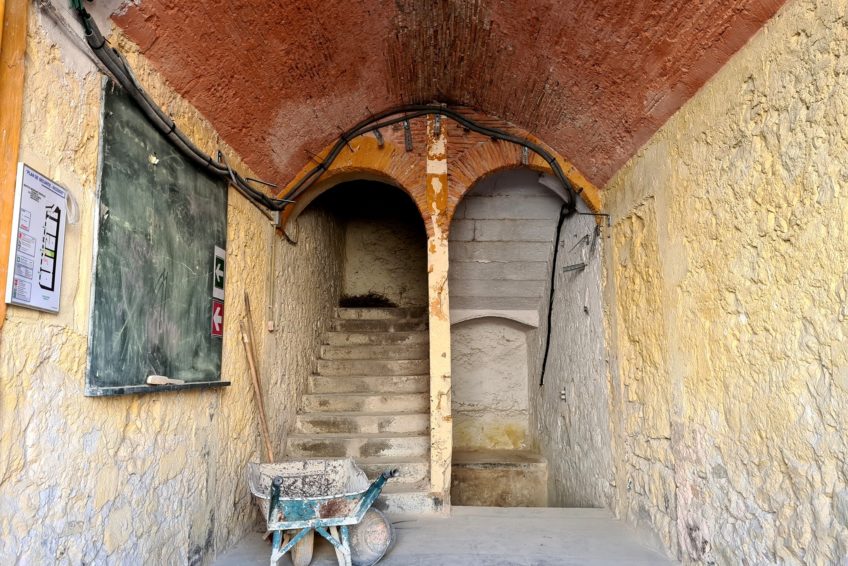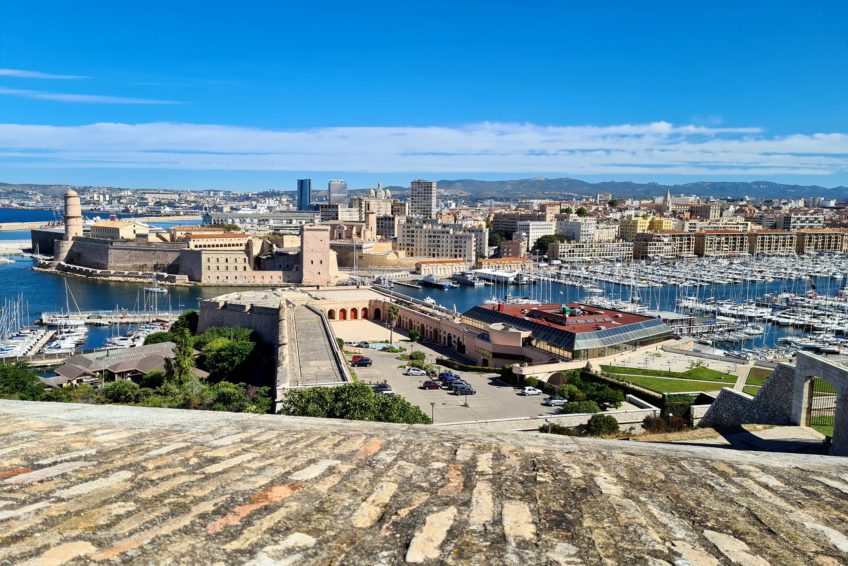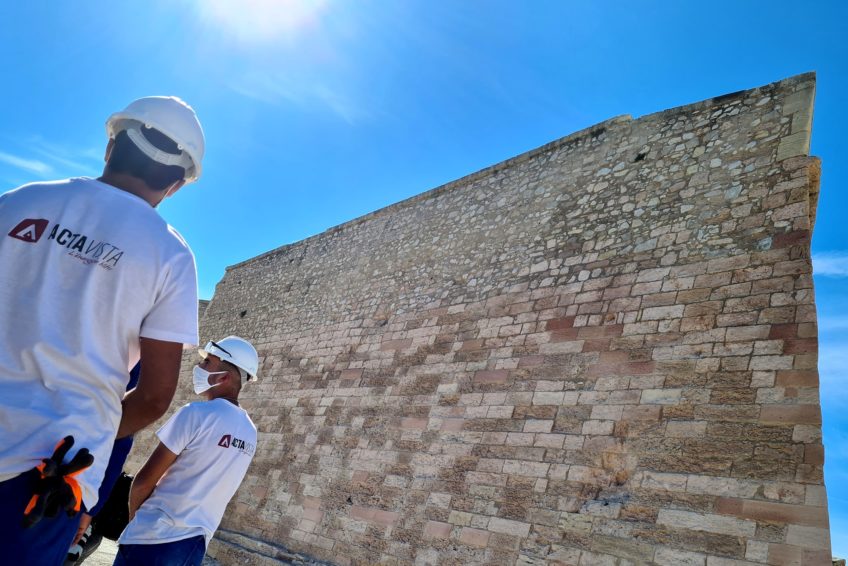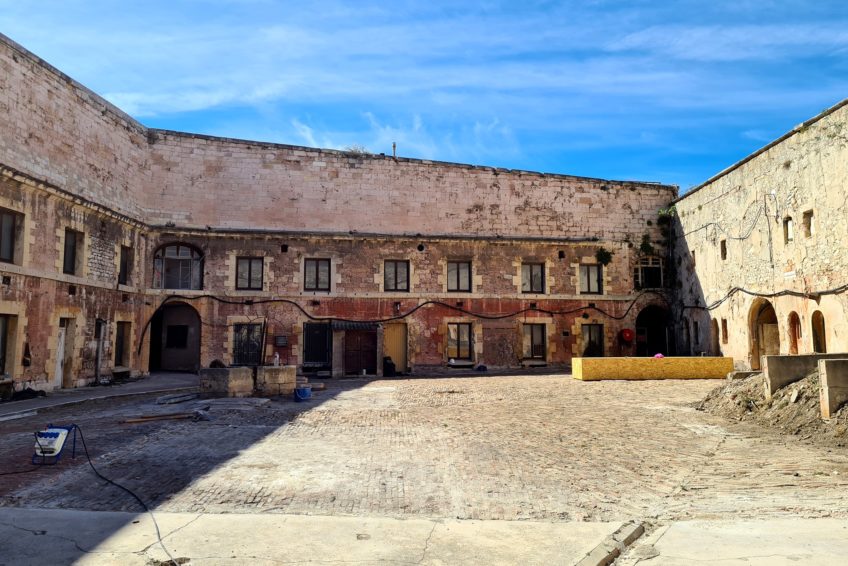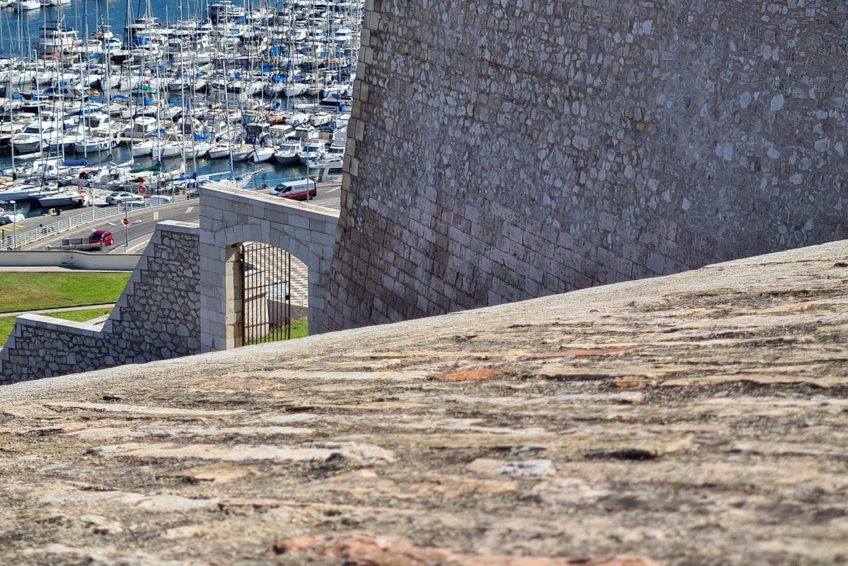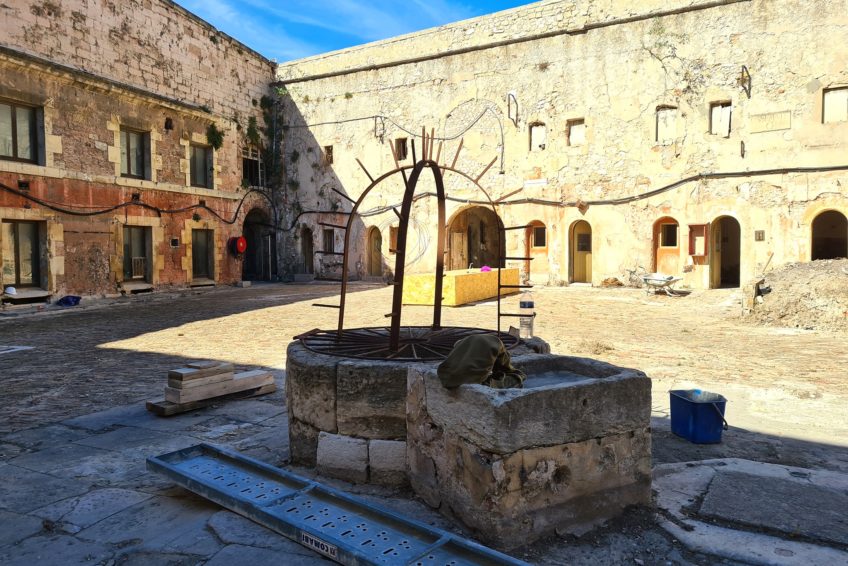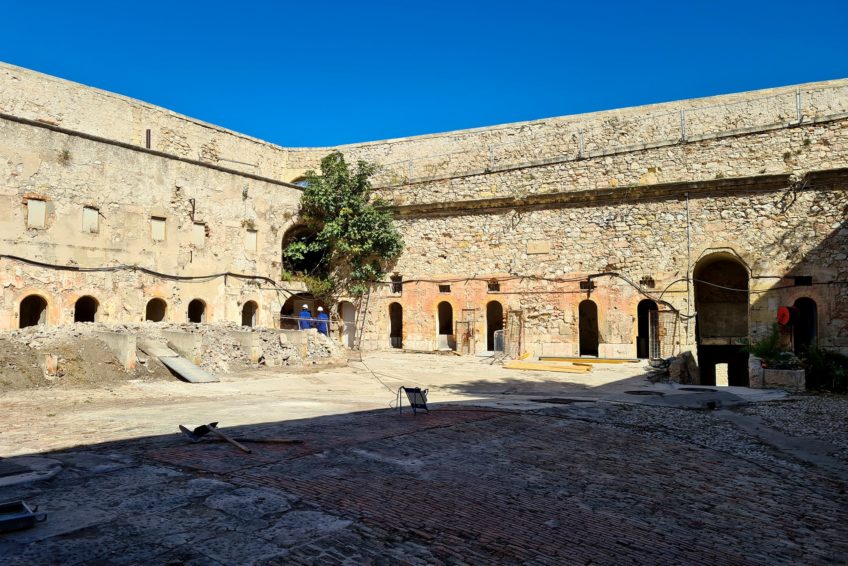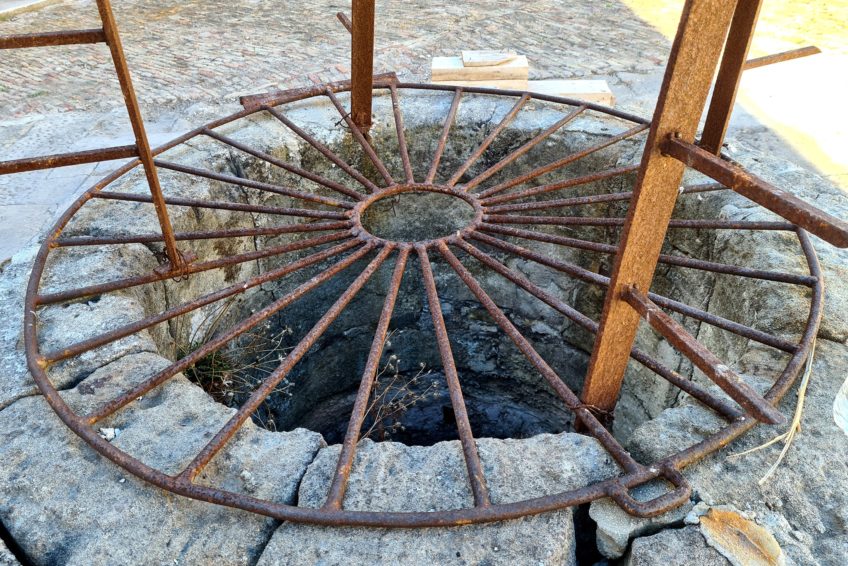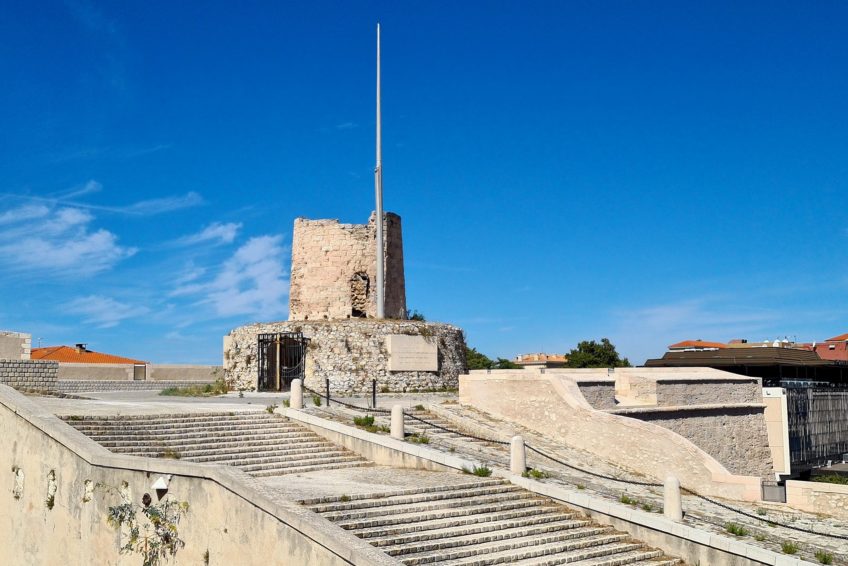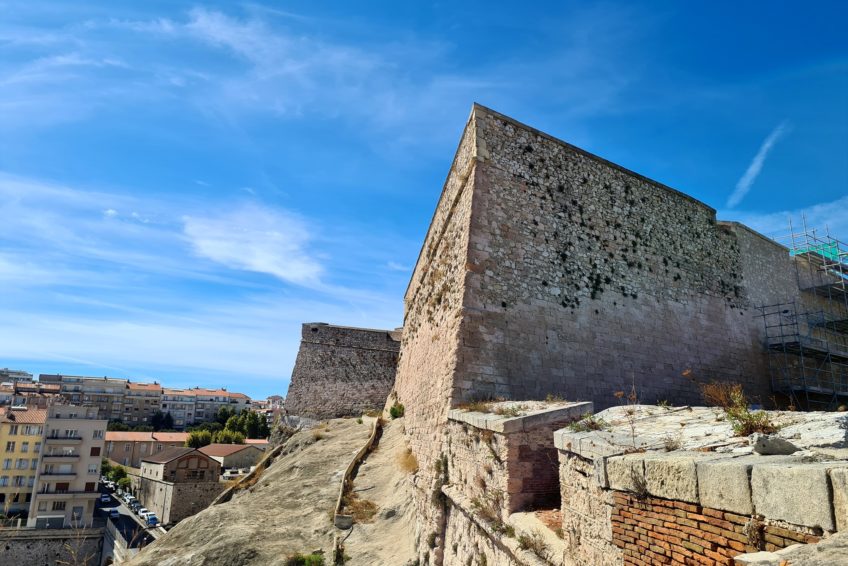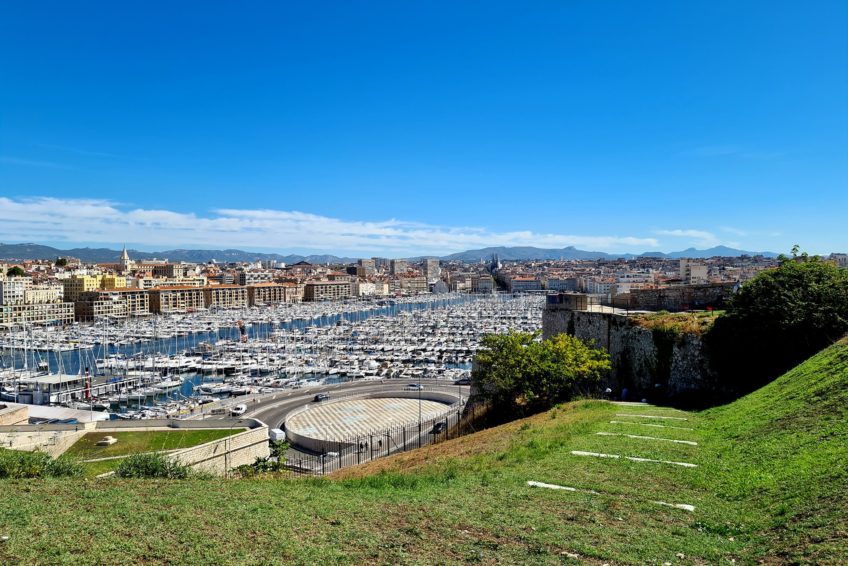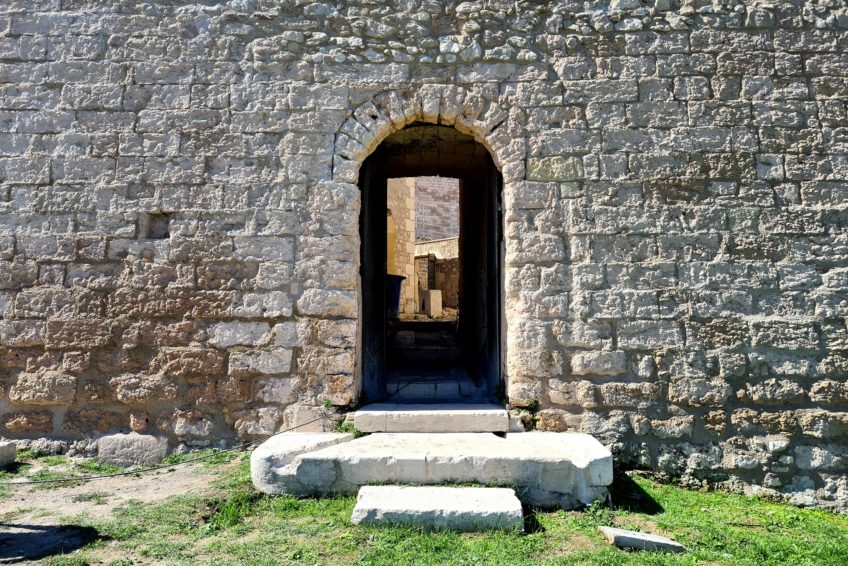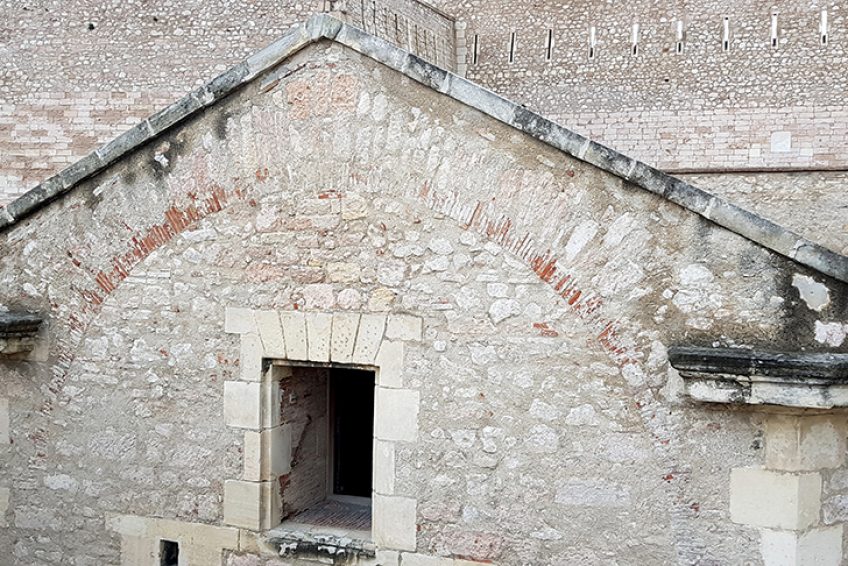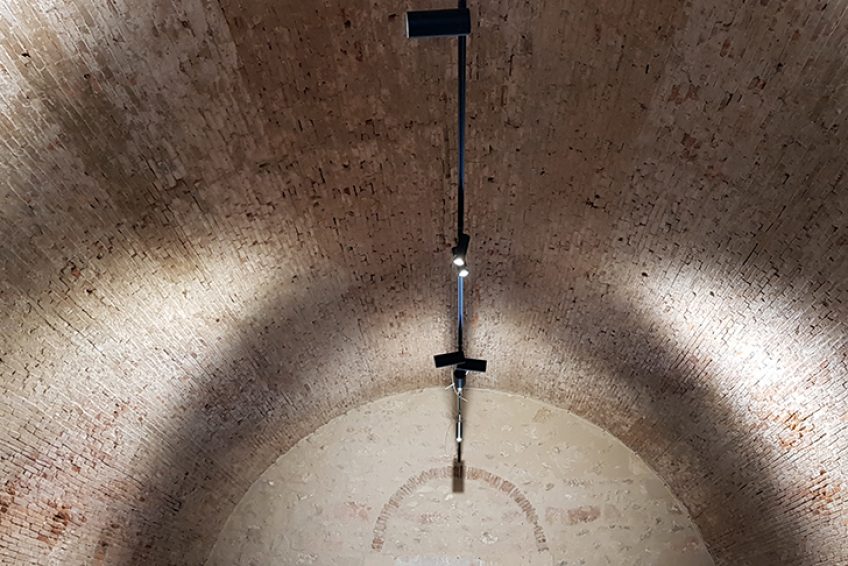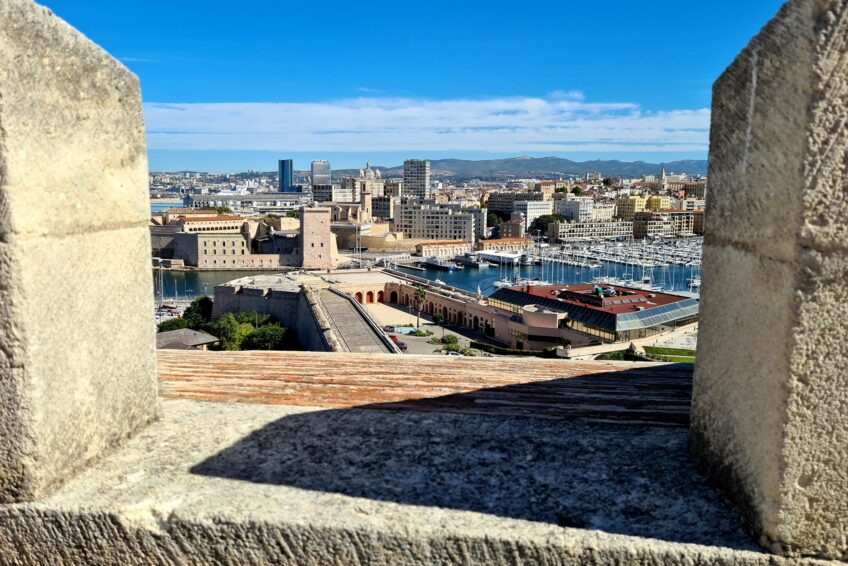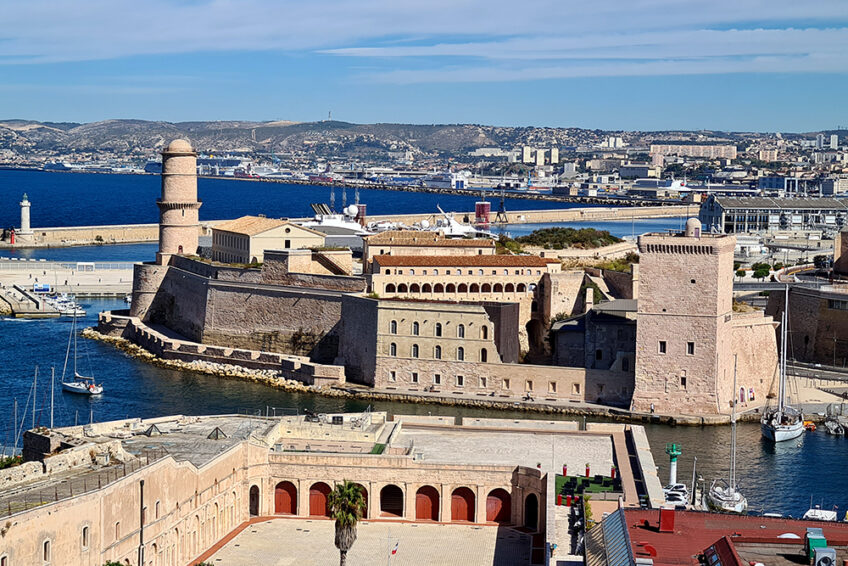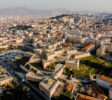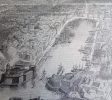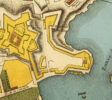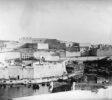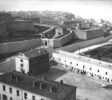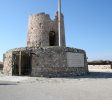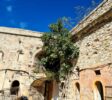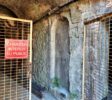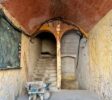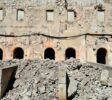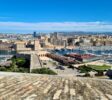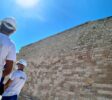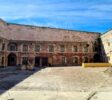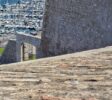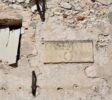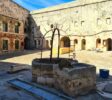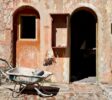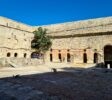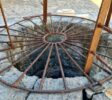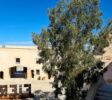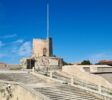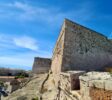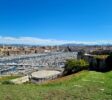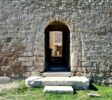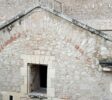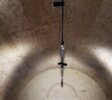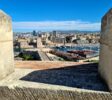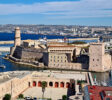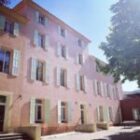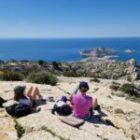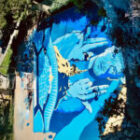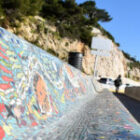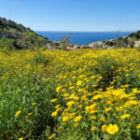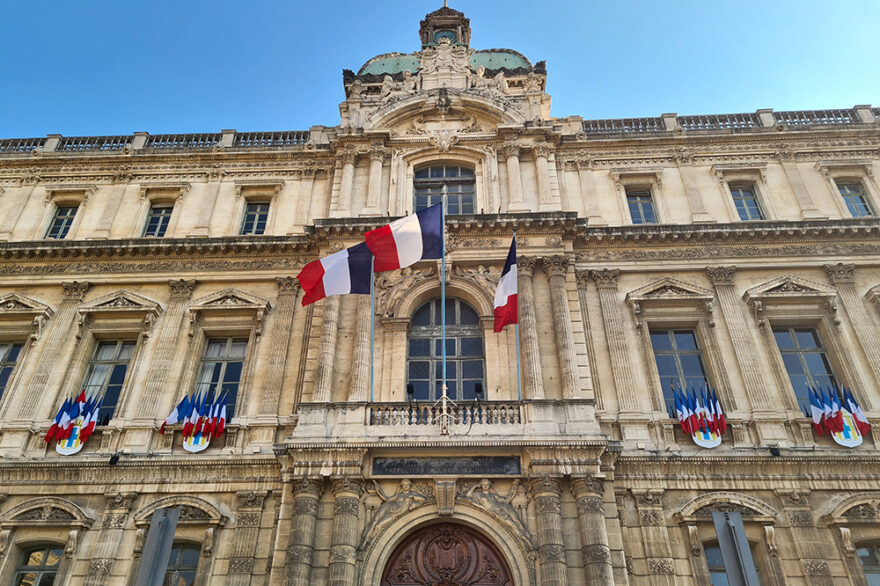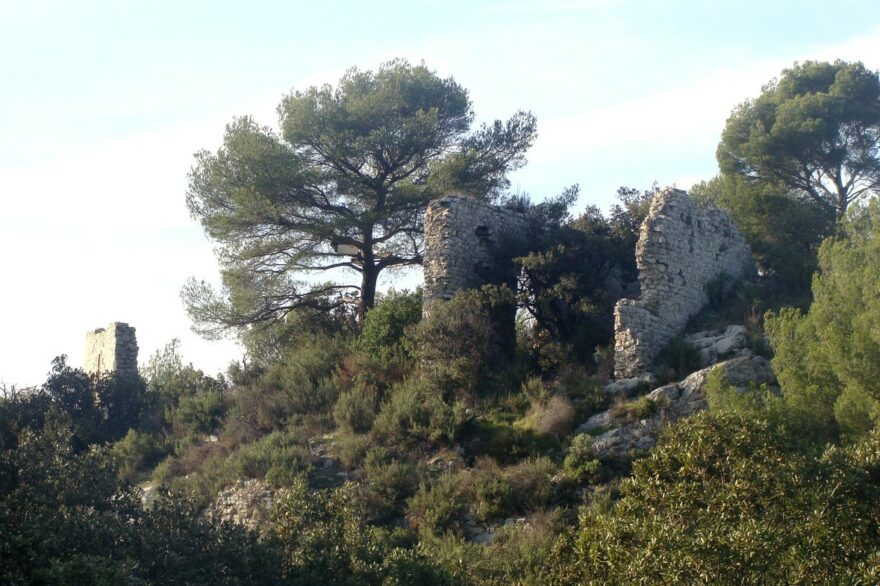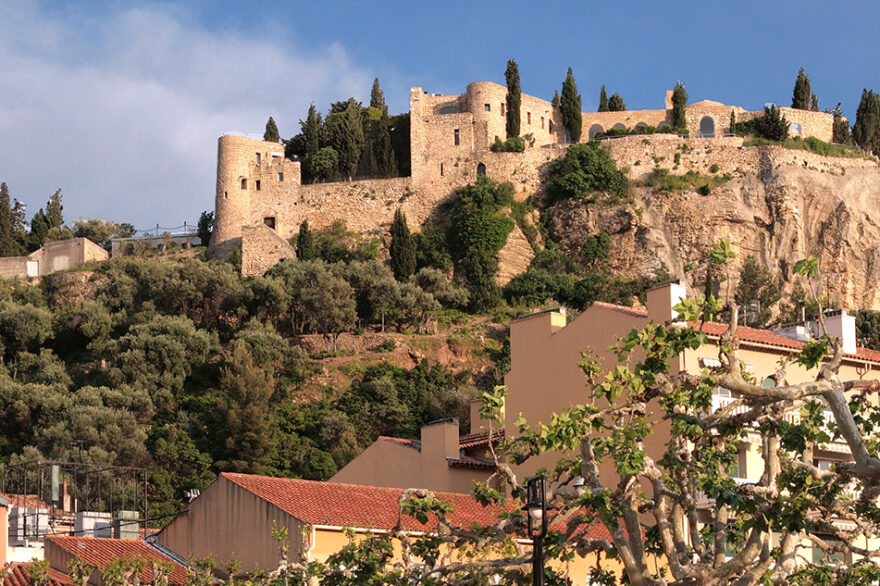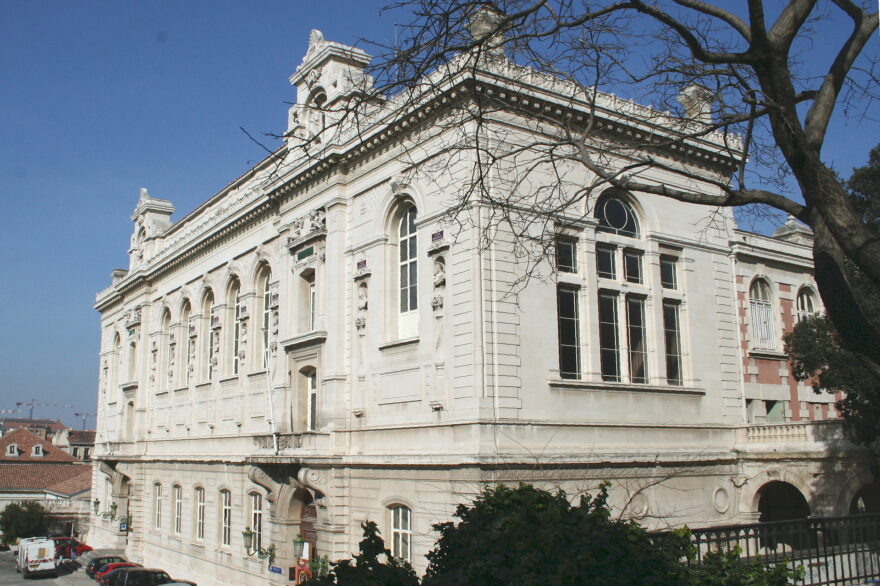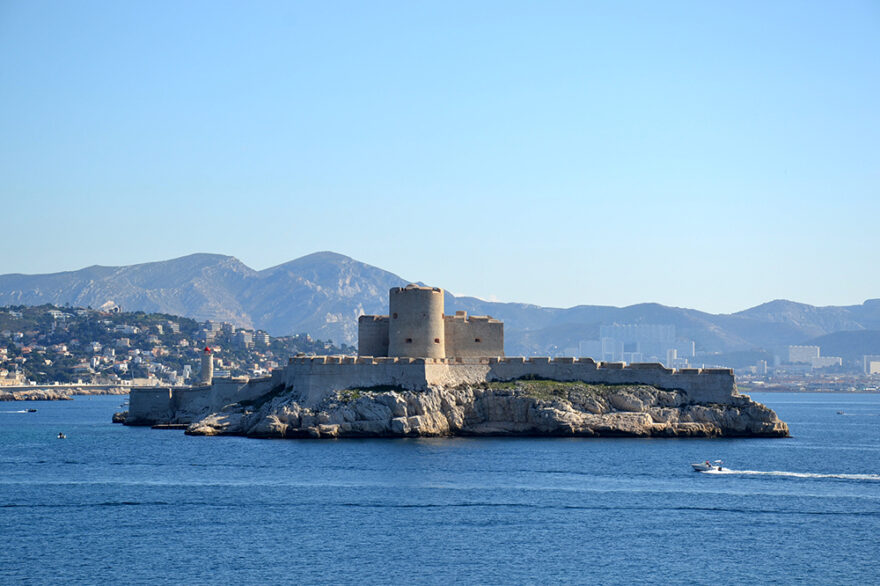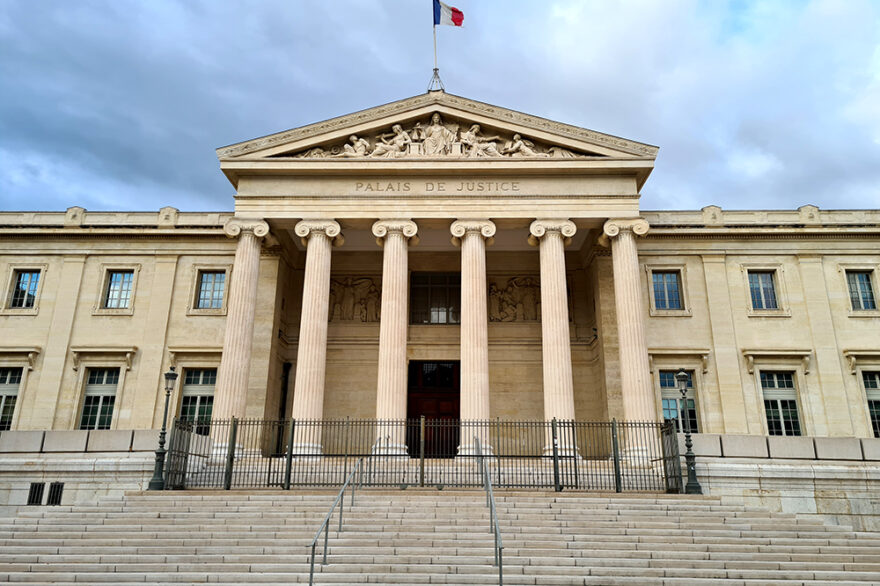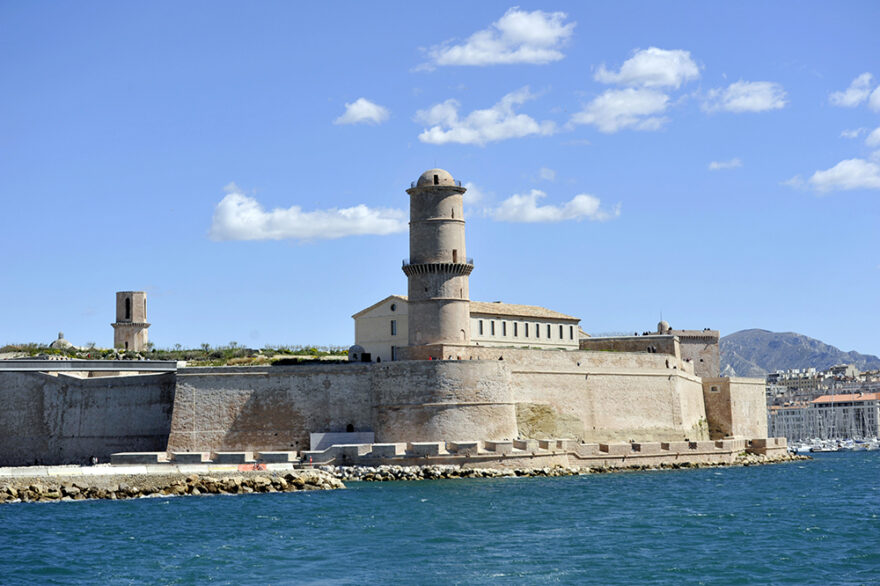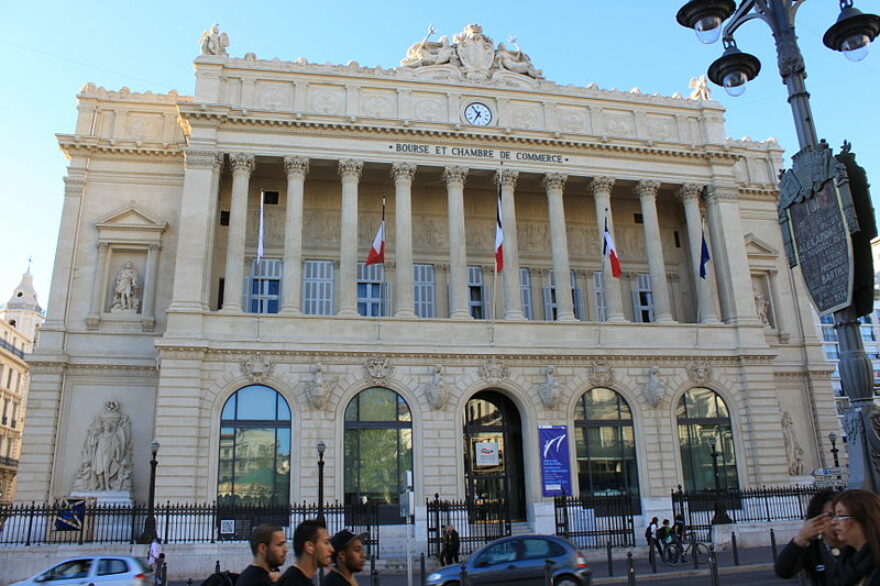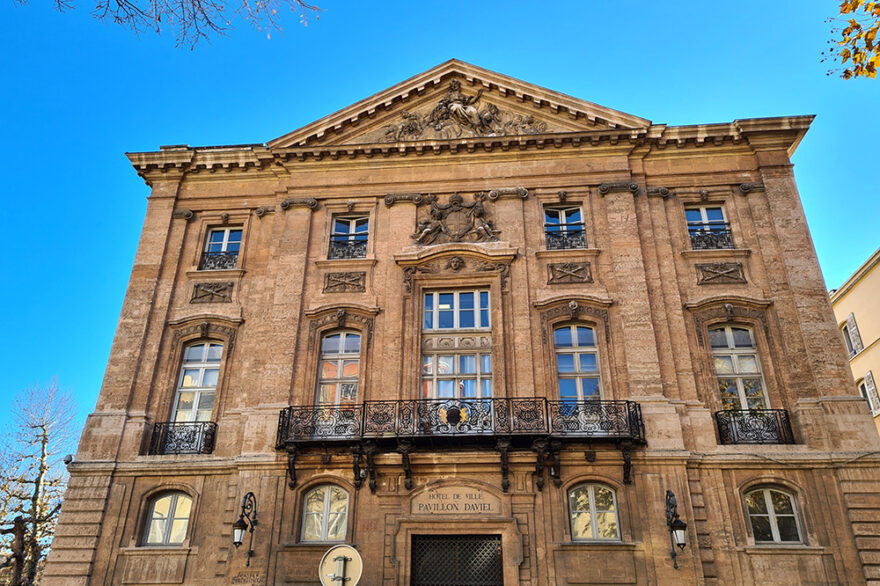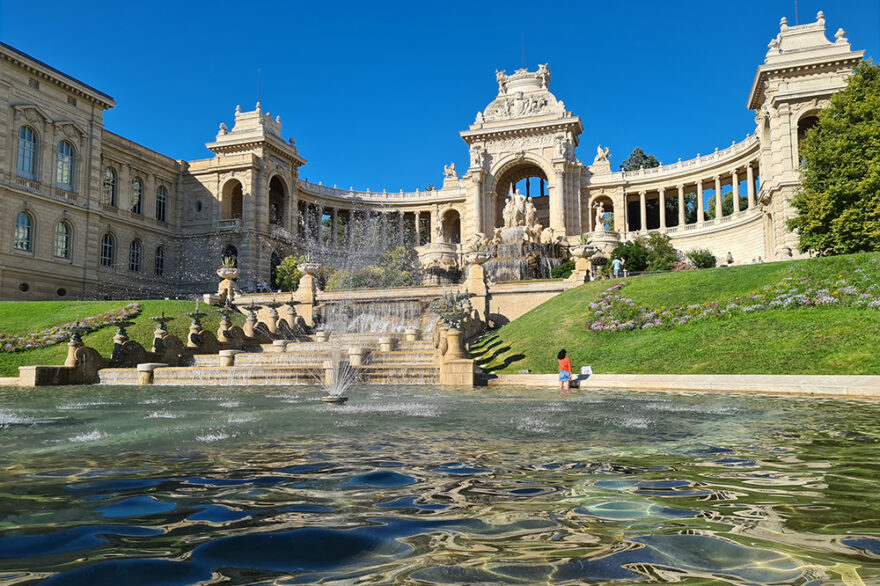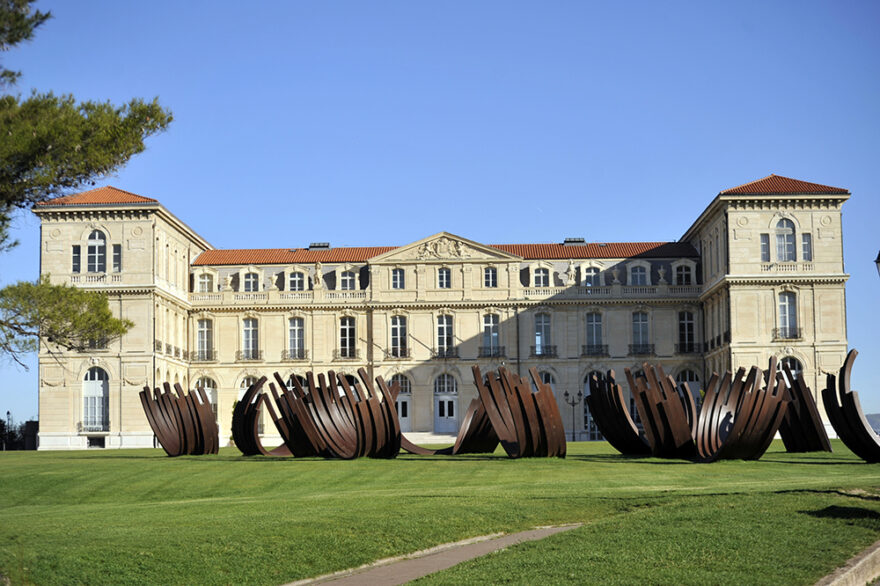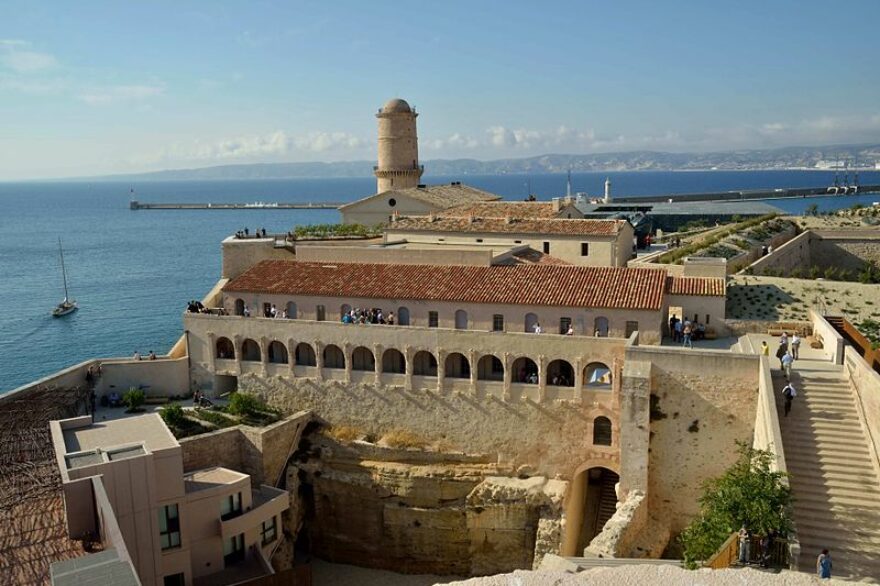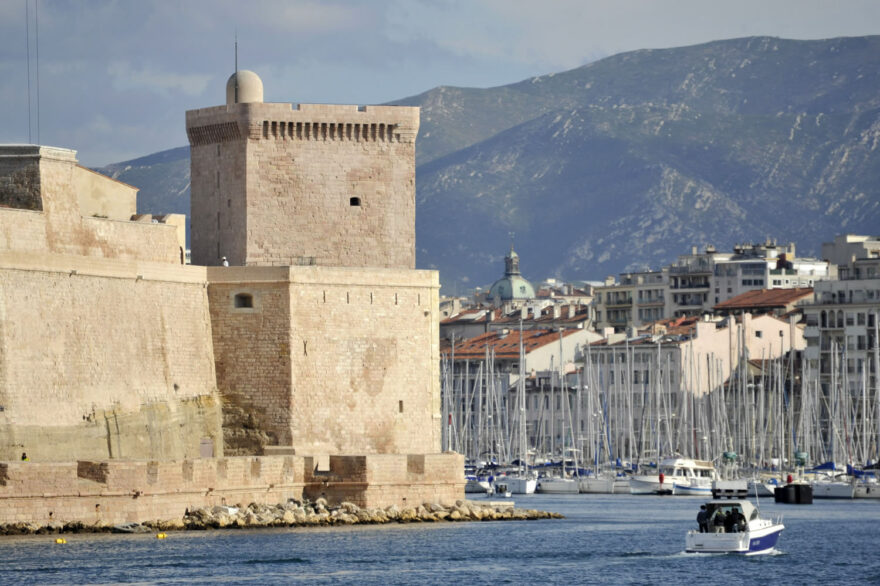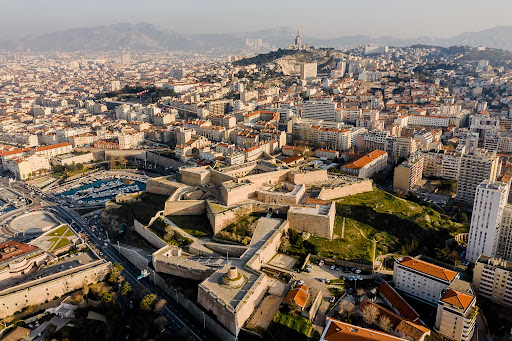
Former occupation of the site
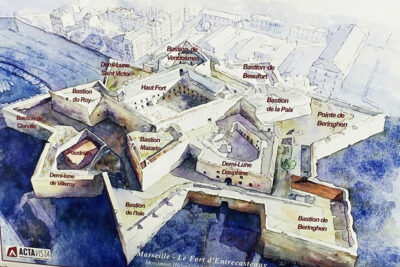 At this location there was a small chapel founded between 1150 and 1218 from the Middle Ages, placed under the patronage of Saint-Nicolas and dependent on theSaint-Victor abbey. At the foot of this chapel, at the level of the narrowest opening between the forts Saint-Jean and Saint-Nicolas, the seneschal of Provence ordered in 1322 the installation of a wooden palisade at the end of which was fixed a chain barring the harbor pass. This palisade is gradually reinforced to form in 1381 two real piles of bridge. On this date, the Saint-Nicolas chapel underwent major work with the construction of a walkway and a wall going as far as the port chain. This defense system proved ineffective during the attack on the city by King Alfonso V of Aragon the November 20 1423.
At this location there was a small chapel founded between 1150 and 1218 from the Middle Ages, placed under the patronage of Saint-Nicolas and dependent on theSaint-Victor abbey. At the foot of this chapel, at the level of the narrowest opening between the forts Saint-Jean and Saint-Nicolas, the seneschal of Provence ordered in 1322 the installation of a wooden palisade at the end of which was fixed a chain barring the harbor pass. This palisade is gradually reinforced to form in 1381 two real piles of bridge. On this date, the Saint-Nicolas chapel underwent major work with the construction of a walkway and a wall going as far as the port chain. This defense system proved ineffective during the attack on the city by King Alfonso V of Aragon the November 20 1423.
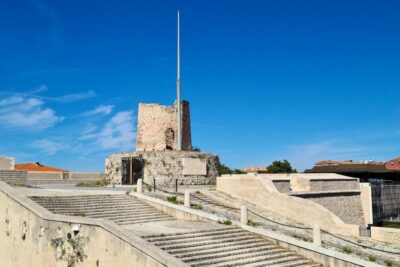 Landed in a neighboring cove, the Aragonese took the chapel from behind and the Catalan galleys were able to enter the port. The city was plundered for three days and the Aragonese took as a trophy the chain of the port which is still on display in the cathedral of Valencia in Spain. In 1591 four individuals Louis Naudet, Gabriel Delassus, Jean Beolan and Antoine Mascaron had the Saint-Nicolas chapel rebuilt. Antoine Mascaron was a friend of Charles de Casaulx and was director of the mint in 1593.
Landed in a neighboring cove, the Aragonese took the chapel from behind and the Catalan galleys were able to enter the port. The city was plundered for three days and the Aragonese took as a trophy the chain of the port which is still on display in the cathedral of Valencia in Spain. In 1591 four individuals Louis Naudet, Gabriel Delassus, Jean Beolan and Antoine Mascaron had the Saint-Nicolas chapel rebuilt. Antoine Mascaron was a friend of Charles de Casaulx and was director of the mint in 1593.
His son, Pierre Mascaron was the first printer in Marseille in 1596 by publishing the book of Bellaud de la Bellaudière: " Obros and rimos provenssalos ».
rebel Marseille
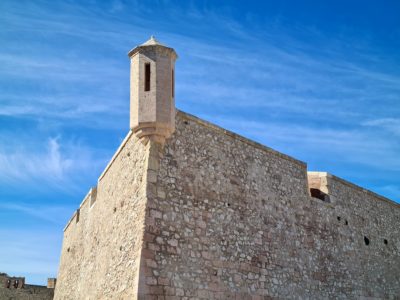 In order to regain control of the management of the city of Marseilles, the Duke of Mercour, governor of Provence, had Lazare de Vento appointed as Lord of La Baume by letters patent of October 1657. The other two consuls were Boniface Pascal and Joseph Fabre. Under the pretext of defending the city against pirates but above all to please Mercour, the consuls decided to arm the galley of the Chevalier de Vendôme, son of the Duke of Mercour, at the expense of the city. This decision provoked strong opposition at the head of which was Gaspard de Glandevès de Niozelles. Riots agitate the city; Niozelles and his supporters seize theCity Hall which is taken over by the troops of the governor who entered the city on the night of July 18 to 19, 1658. In October 1658 the supporters of Niozelles won the elections which were canceled by the king. Louis XIV orders the leaders of the opposition to come and find him.
In order to regain control of the management of the city of Marseilles, the Duke of Mercour, governor of Provence, had Lazare de Vento appointed as Lord of La Baume by letters patent of October 1657. The other two consuls were Boniface Pascal and Joseph Fabre. Under the pretext of defending the city against pirates but above all to please Mercour, the consuls decided to arm the galley of the Chevalier de Vendôme, son of the Duke of Mercour, at the expense of the city. This decision provoked strong opposition at the head of which was Gaspard de Glandevès de Niozelles. Riots agitate the city; Niozelles and his supporters seize theCity Hall which is taken over by the troops of the governor who entered the city on the night of July 18 to 19, 1658. In October 1658 the supporters of Niozelles won the elections which were canceled by the king. Louis XIV orders the leaders of the opposition to come and find him.
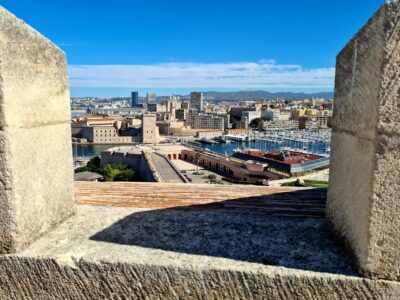 The interview takes place in Paris on January 6, 1659, but then the incidents multiply. Henri de Forbin-Maynier, baron d'Oppède, president of the parliament of Provence considers that only a personal intervention of the king is essential to subject Marseilles and proposes this solution to Mazarin. The opportunity is provided by a serious incident. Gouvernelle, lieutenant of the Mercour guards, was instructed to bring a new summons to court to Niozelles. This document bearing the king's signature was torn from him and lacerated.
The interview takes place in Paris on January 6, 1659, but then the incidents multiply. Henri de Forbin-Maynier, baron d'Oppède, president of the parliament of Provence considers that only a personal intervention of the king is essential to subject Marseilles and proposes this solution to Mazarin. The opportunity is provided by a serious incident. Gouvernelle, lieutenant of the Mercour guards, was instructed to bring a new summons to court to Niozelles. This document bearing the king's signature was torn from him and lacerated.
The intervention of the king became inevitable in the face of such a rebellion. From the Basque coast where he had just signed the Treaty of the Pyrenees, Louis XIV, accompanied by Mazarin, the Queen Mother and the Court, went to Toulouse, Beaucaire, Tarascon; he is in Arles on January 13, 1660 and in Aix-en-Provence on January 18, 1660.
The decision to build a citadel
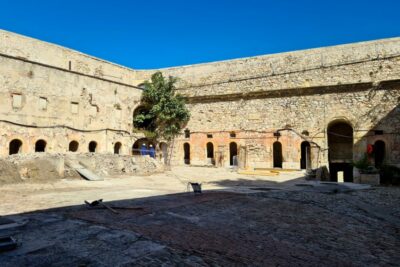 On January 19, 1660, King Louis XIV sent a letter to the Duke of Mercour, Governor of Provence, specifying his decision to send troops to Marseilles in order to prevent the continuation of the disorders. This letter was accompanied by an instruction which prescribed several obligations to Mercour, including the construction of a citadel “in the place of the said city which will be judged the cleanest”. This project had been suggested to Mazarin by the Duke of Mercour and Henri de Forbin-Maynier, Baron d'Oppède. Mazarin sent to Marseilles the famous military engineer, the Chevalier Louis Nicolas de Clerville, whom he had brought from Nancy on purpose.
On January 19, 1660, King Louis XIV sent a letter to the Duke of Mercour, Governor of Provence, specifying his decision to send troops to Marseilles in order to prevent the continuation of the disorders. This letter was accompanied by an instruction which prescribed several obligations to Mercour, including the construction of a citadel “in the place of the said city which will be judged the cleanest”. This project had been suggested to Mazarin by the Duke of Mercour and Henri de Forbin-Maynier, Baron d'Oppède. Mazarin sent to Marseilles the famous military engineer, the Chevalier Louis Nicolas de Clerville, whom he had brought from Nancy on purpose.
Clerville proceeded in the first place to the choice of the establishment which was to allow both the surveillance of the city but also its protection against an attack coming from the sea.
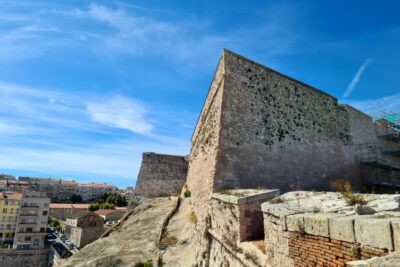 Clerville parted the hill St. Charles because it was too far from the shore to allow a supply by sea. He therefore retained the current location, behind theAbbey of Saint-Victor and whose extent was sufficient "to maintain there forever the authority of the king." This site was also equipped with a fresh water fountain which appears on the old maps.
Clerville parted the hill St. Charles because it was too far from the shore to allow a supply by sea. He therefore retained the current location, behind theAbbey of Saint-Victor and whose extent was sufficient "to maintain there forever the authority of the king." This site was also equipped with a fresh water fountain which appears on the old maps.
Mazarin did not immediately agree with this opinion and sent Marshal du Plessis-Praslin to Marseilles to have another opinion. He would have preferred a location where the current Pharo Palace, but then sided with the Chevalier de Clerville.
The works
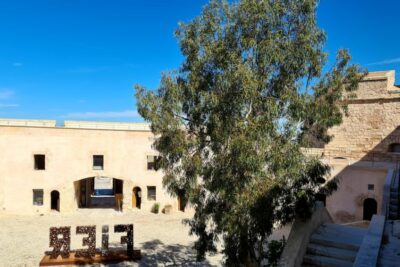 Clerville, who had gone to Aix-en-Provence to have his plans approved by Mazarin, had the work started immediately, using the materials from the demolition of the Porte Royale and the surrounding walls constituting the old ramparts of Marseille. THE Cape Crown stones were also used. The Duke of Mercour laid the first stone on February 11, 1660, on which was engraved " for fear that faithful Marseilles, too often prey to the criminal agitations of a few seditious people, would finally lose the city and the kingdom either by the ardor of the boldest or by an excessive passion for freedom and which the King of the French wanted to provide by this citadel to the safety of the great and the people. ". Three commemorative medals were struck to recall this event. On March 2, 1660 when Louis XIV entered Marseille, the site was in full swing.
Clerville, who had gone to Aix-en-Provence to have his plans approved by Mazarin, had the work started immediately, using the materials from the demolition of the Porte Royale and the surrounding walls constituting the old ramparts of Marseille. THE Cape Crown stones were also used. The Duke of Mercour laid the first stone on February 11, 1660, on which was engraved " for fear that faithful Marseilles, too often prey to the criminal agitations of a few seditious people, would finally lose the city and the kingdom either by the ardor of the boldest or by an excessive passion for freedom and which the King of the French wanted to provide by this citadel to the safety of the great and the people. ". Three commemorative medals were struck to recall this event. On March 2, 1660 when Louis XIV entered Marseille, the site was in full swing.
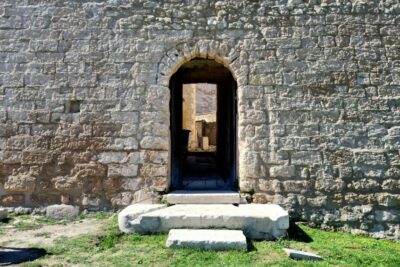 Construction was completed in record time for a building of this size. In fact, the upper fort was finished by master mason Jean Étienne Chieuse in 1663. The work on the lower fort, the part located north of boulevard Charles Livon and between the quai Marcel Pagnol and reserve harbor, were interrupted on the death of Mazarin on March 9, 1661; Le Guette decided to take them back on July 16, 1663 by making a deal with seven masons including Pierre Puget, first cousin and namesake of Pierre Puget, sculptor. The work was completed in 1664. Vauban, who was not involved in the construction of the citadel, visited the fort and wrote a very critical letter on March 16, 1679: “ I visited the citadel of Marseilles which is a very magnificent assemblage of all that has ever passed from extravagant and ridiculous by the heads of the meanest engineers in the world. ". In 1701, Vauban proposes modifications which will not be carried out.
Construction was completed in record time for a building of this size. In fact, the upper fort was finished by master mason Jean Étienne Chieuse in 1663. The work on the lower fort, the part located north of boulevard Charles Livon and between the quai Marcel Pagnol and reserve harbor, were interrupted on the death of Mazarin on March 9, 1661; Le Guette decided to take them back on July 16, 1663 by making a deal with seven masons including Pierre Puget, first cousin and namesake of Pierre Puget, sculptor. The work was completed in 1664. Vauban, who was not involved in the construction of the citadel, visited the fort and wrote a very critical letter on March 16, 1679: “ I visited the citadel of Marseilles which is a very magnificent assemblage of all that has ever passed from extravagant and ridiculous by the heads of the meanest engineers in the world. ". In 1701, Vauban proposes modifications which will not be carried out.
The governor of this new citadel was annoyed by the proximity of the Lazaret which extended from the foot of the new fort to the cove of the Old Infirmaries, currently Catalans beach. He asked for the transfer of the Lazaret which was established by the city near Saint-Martin d'Arenc. After the plague of 1720, some Catalan fishermen came to practice in the area and settled in the disused premises of the infirmary, hence the name given to the district.
Amputations
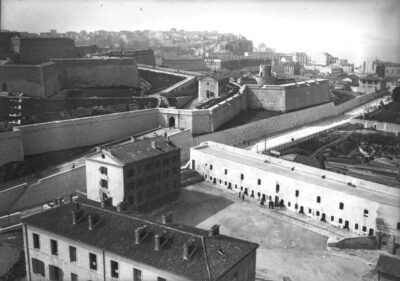 During the Revolution, the presence of forts Saint-Jean, St. Nicholas and Our Lady of the Guard worried the population because some thought that their commanders were accumulating ammunition there. On April 30, 1790, the general council of the commune (equivalent to the municipal council) presented itself at the door of the Saint-Nicolas citadel. Major de la Roque, commander of the fort, thinking that his small troop, ex-Vexin regiment was going to defect, signed a compromise under the terms of which he would let in as many National Guardsmen as there were soldiers in his service every day. . Following various incidents, the crowd began on May 18, 1790 the destruction of the eastern part of this monument symbol of despotism, but the National Assembly, anxious to preserve a work useful for the defense of the city, ordered to stop the demolition of the fortress by decree of May 28, 1790. In 1833, the prefect Thomas had the demolished parts restored, but this restoration was done with greyish stones of poor quality, sharply contrasting with the undestroyed parts made of pink stones from Cap Couronne. In order to connect the Old Port au Pharo Palace which was accessible only by the boulevard of the Corderie and the avenue of the Residence currently avenue Pasteur, the municipal commission voted on April 18, 1860 the opening of a way, currently boulevard Charles Livon.
During the Revolution, the presence of forts Saint-Jean, St. Nicholas and Our Lady of the Guard worried the population because some thought that their commanders were accumulating ammunition there. On April 30, 1790, the general council of the commune (equivalent to the municipal council) presented itself at the door of the Saint-Nicolas citadel. Major de la Roque, commander of the fort, thinking that his small troop, ex-Vexin regiment was going to defect, signed a compromise under the terms of which he would let in as many National Guardsmen as there were soldiers in his service every day. . Following various incidents, the crowd began on May 18, 1790 the destruction of the eastern part of this monument symbol of despotism, but the National Assembly, anxious to preserve a work useful for the defense of the city, ordered to stop the demolition of the fortress by decree of May 28, 1790. In 1833, the prefect Thomas had the demolished parts restored, but this restoration was done with greyish stones of poor quality, sharply contrasting with the undestroyed parts made of pink stones from Cap Couronne. In order to connect the Old Port au Pharo Palace which was accessible only by the boulevard of the Corderie and the avenue of the Residence currently avenue Pasteur, the municipal commission voted on April 18, 1860 the opening of a way, currently boulevard Charles Livon.
The retaining walls of the trench made for the passage of this new road are made of white Urgonian limestone which clearly contrasts with the pink stones of Cap Couronne used for the construction of the fort. The citadel was thus cut into two independent parts.
The prison
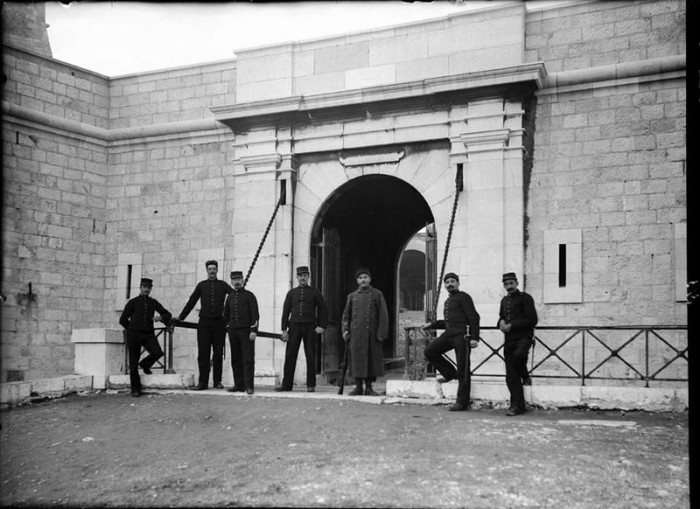 The fort received, in 1823, following the expedition of the Duke of Angoulême in Spain, 569 prisoners including the soldier Valdès who had been one of the organizers of the guerrilla war against the Napoleonic troops after 1808. On April 30, 1832, he also served as a place of detention for the sailors of the boat which had landed the Duchess of Berry on April 28, 1832 near Carry-le-Rouet and which had been boarded by the steamer "Le Sphinx" near the green island in La Ciotat . Fort Saint-Nicolas remained a prison until the end of the last war. Among the famous prisoners we can mention: the writer Jean Giono who had been arrested in Digne on September 16, 1939 because of his previous pacifist publications, was imprisoned in Fort Saint-Nicolas. He is released in mid-November after the pronunciation of a dismissal. In his novel Noé, the writer recalls this episode in his life: high on the horizon and completely walling off the entire bottom of the Canebière, the magnificent crown-shaped body of Fort Saint-Nicolas. The great wall of the fort facing me ends to the left with a beautiful bow ridge. It is exactly in this prow that I had my cell in 1939. »;
The fort received, in 1823, following the expedition of the Duke of Angoulême in Spain, 569 prisoners including the soldier Valdès who had been one of the organizers of the guerrilla war against the Napoleonic troops after 1808. On April 30, 1832, he also served as a place of detention for the sailors of the boat which had landed the Duchess of Berry on April 28, 1832 near Carry-le-Rouet and which had been boarded by the steamer "Le Sphinx" near the green island in La Ciotat . Fort Saint-Nicolas remained a prison until the end of the last war. Among the famous prisoners we can mention: the writer Jean Giono who had been arrested in Digne on September 16, 1939 because of his previous pacifist publications, was imprisoned in Fort Saint-Nicolas. He is released in mid-November after the pronunciation of a dismissal. In his novel Noé, the writer recalls this episode in his life: high on the horizon and completely walling off the entire bottom of the Canebière, the magnificent crown-shaped body of Fort Saint-Nicolas. The great wall of the fort facing me ends to the left with a beautiful bow ridge. It is exactly in this prow that I had my cell in 1939. »;
Jean Zay (socialist MP, 1940, following his conviction for “desertion” by the Vichy regime); Hédi Nouira (Tunisian politician, same period); Habib Bourguiba (Tunisian politician, 1940-1942).
Current occupation
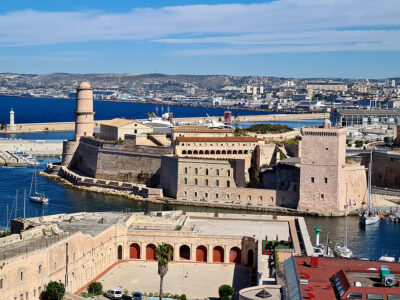
Below the Fort Ganteaume
The part located between the boulevard Charles Livon and the sea is the low fort which took the name of Fort Ganteaume in homage to a former vice-admiral, maritime prefect, Ganteaume. It houses the military circle with the officers' mess. The other part to the south of the boulevard is the high fort which is also called fort d'Entrecasteaux from the name of an admiral related to the bailiff of Suffren, Entrecasteaux. It is made up of two interlocking enclosures. The high fort has been restored since 2003 by the ACTA VISTA association as part of training sites for heritage trades. ACTA VISTA set up its headquarters there in 2005. In 2009 ACTA VISTA created its training and apprenticeship center for trades in old built heritage and eco-construction, supported by the European Union, this training center makes it possible to hire and train more than 350 people each year. . Thanks to its many patrons, the ACTA VISTA association has enabled the restoration of the East, North and West ramparts (600 ml), the half moon of Villeroy (Poudriere), the half moon Dauphine and the Bastion of Beringhen, different areas of Fort d'Entrecasteaux dedicated to apprenticeship, training, professional integration and the culture of crafts.
The former windmill has become since 1954 a memorial to the war dead. Access is via a door to the east. The central part of the high fort depends on the army and cannot be visited.
Rock island
The festival Electro Rock Island sometimes occupied the Fort in July for its event, as in 2013 and 2015.
Reproduction of the Cosquer cave
According to Provence the construction of this reproduction figured in Jean-Claude Gaudin's program for the 2014 municipal election in the cellars of Fort d'Entrecasteaux, at the foot of the Saint-Maurice ramp. It will finally be Mediterranean Villa in 2022.
The future of the Fort
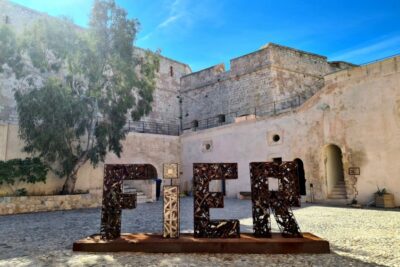 In May 2017 the municipality relaunched a call for projects, the 3rd in 5 years, to imagine the conversion of the upper part of Fort d'Entrecasteaux. The ambition is to stage and open up this 51.260 m² citadel to the city, which was classified as a historical monument in 1969. The site was bought by the municipality in 2010 from the Ministry of Defense for €10 million in order to make it flagship of the tourism development program. The city intended to make the site available to a private operator or a group of operators without requiring a user fee. The city was waiting for a proposal built on the idea of "da fair balance between public and private usess”. The lessee should comply with several requirements, including " the opening to the public of the fort and therefore the creation of a new place for the Marseillais thus reinforcing the development of the tourist attractiveness of the city ».
In May 2017 the municipality relaunched a call for projects, the 3rd in 5 years, to imagine the conversion of the upper part of Fort d'Entrecasteaux. The ambition is to stage and open up this 51.260 m² citadel to the city, which was classified as a historical monument in 1969. The site was bought by the municipality in 2010 from the Ministry of Defense for €10 million in order to make it flagship of the tourism development program. The city intended to make the site available to a private operator or a group of operators without requiring a user fee. The city was waiting for a proposal built on the idea of "da fair balance between public and private usess”. The lessee should comply with several requirements, including " the opening to the public of the fort and therefore the creation of a new place for the Marseillais thus reinforcing the development of the tourist attractiveness of the city ».
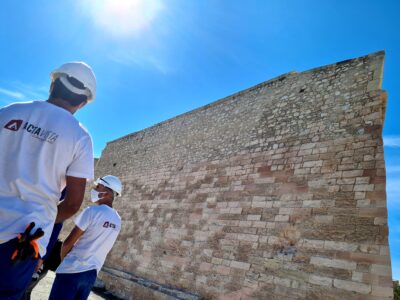 In a first phase, going until February 3, 2025, the operator will have to respect the temporary occupation authorization granted by the town hall with the Acta Vista association. An agreement which provides for the maintenance of 98 integration jobs on the site. This application had to take into account the project of cable car call to link the site to Our Lady of the Guard. The deadline for submitting applications was set for May 23, 2017. This is the “citadel of Marseille” project carried out by the social and solidarity economy group SOS, already in charge of the renovation of the fort, which will invest from 2019 the restored part of the fort as a place for exhibitions, cultural and leisure events. The group plans to invest 1,5 million euros from the outset, but more than 50 million euros will be spent in total over forty years. The SOS Group plans to install monumental works all along the ramparts like an open-air museum with interactive walks to discover the site as it was in the XNUMXth century and projections on the ramparts. Another aspect is the creation of residences for local and international artists. The site will also house a brasserie, a grocery store and a micro-farm.
In a first phase, going until February 3, 2025, the operator will have to respect the temporary occupation authorization granted by the town hall with the Acta Vista association. An agreement which provides for the maintenance of 98 integration jobs on the site. This application had to take into account the project of cable car call to link the site to Our Lady of the Guard. The deadline for submitting applications was set for May 23, 2017. This is the “citadel of Marseille” project carried out by the social and solidarity economy group SOS, already in charge of the renovation of the fort, which will invest from 2019 the restored part of the fort as a place for exhibitions, cultural and leisure events. The group plans to invest 1,5 million euros from the outset, but more than 50 million euros will be spent in total over forty years. The SOS Group plans to install monumental works all along the ramparts like an open-air museum with interactive walks to discover the site as it was in the XNUMXth century and projections on the ramparts. Another aspect is the creation of residences for local and international artists. The site will also house a brasserie, a grocery store and a micro-farm.
In a second step, when the upper part will be renovated by 2027, this space could possibly accommodate a business incubator.
